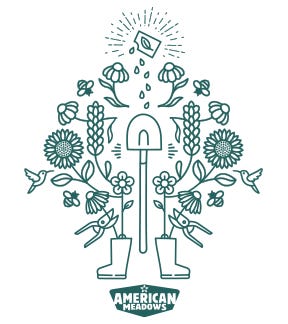Part Of The American Meadows Meadowscaping Learning Center
Massachusetts Native Plants, State Flowers & State Bird
Native plants are adaptable, low-maintenance, and beautiful. They are the best choice for habitat-friendly gardens and thriving ecosystems. Find top picks for native plants in your state - and learn about your state bird and state flowers!
Follow Along With More Of Our Guides
Hello native plant enthusiasts! In the list below, you will find popular native plants and wildflower seeds, available from American Meadows, that have a native distribution in your state. You’ll also find information about your state bird, state flower, and state wildflower!
About Our Native Plant Lists For Each State
- The links will take you to a single plant or seed selection for the plant listed -- but in many cases, we offer multiple cultivars for each plant, and we may offer both seeds and potted plants to grow the plant on your list. This list is a work in progress as we expand our native plant educational resources.
- The list for your state is a great place for getting started with native plants - but it is by no means a comprehensive listing of the hundreds of native plants growing in each state.
Massachusetts Native Plants
Grow our Native Northeast Wildflower Seed Mix
Virginia Bluebells (Mertensia virginica)
Showy Goldenrod (Solidago speciosa)
Wrinkleleaf Goldenrod (Solidago rugosa)
Perennial Lupine (Lupinus perennis)
Black Eyed Susan (Rudbeckia fulgida)
Black Eyed Susan or Gloriosa Daisy (Rudbeckia hirta)
Pale Purple Coneflower (Echinacea pallida)
Yellow Prairie Coneflower (Ratibida columnifera)
Gray Headed Coneflower (Ratibida pinnata)
Butterfly Weed (Asclepias tuberosa)
Swamp Milkweed (Asclepias incarnata)
Common Milkweed (Asclepias syriaca)
White Trillium (Trillium grandiflorum)
Red Trillium (Trillium erectum)
Painted Trillium (Trillium undulatum)
Long Beaked Sedge (Carex sprengelii)
White Tinged Sedge (Carex albicans)
Appalachian Sedge (Carex appalachia)
Firewheel (Gaillardia pulchella)
Blanket Flower (Gaillardia aristata)
Lanceleaf Coreopsis (Coreopsis lanceolata)
Pink Coreopsis (Coreopsis rosea)
Wild Bergamot (Monarda fistulosa)
Wild Geranium (Geranium maculatum)
Elderberry (Sambucus canadensis)
Black Cohosh (Actaea racemosa)
Phlox subulata (Creeping Phlox)
Obedient Plant (Physostegia virginiana)
Red Cardinal Flower (Lobelia cardinalis)
Blazing Star (Liatris spicata)
Prairie Blazing Star (Liatris pycnostachya)
Meadow Anemone (Anemone canadensis)
Lacy Phacelia (Phacelia tanacetifolia)
Bottlebrush Grass (Elymus hystrix)
Muhly Grass (Muhlenbergia capillaris)
Big Bluestem (Andropogon gerardii)
Little Bluestem (Schizachyrium scoparium)
Tufted Hair Grass (Deschampsia cespitosa)
Northern Sea Oats (Chasmanthium latifolium)
Yellow Prairie Grass (Sorghastrum nutans)
Wild Strawberry (Fragaria virginiana)
Lowbush Blueberry (Vaccinium angustifolium)
Smooth Blue Aster (Symphyotrichum laeve)
New England Aster (Symphyotrichum novae-angliae)
Ironweed (Vernonia fasciculata)
Common White Yarrow (Achillea millefolium)
Heliopsis (Heliopsis helianthoides)
Massachusetts State Bird, State Flower & State Wildflower

Black-Capped Chickadee ~ Parus atricapillus
In summer, the Black-Capped Chickadee feeds mainly on insects, seeds, wild berries, and other fruits. Because he can alight upside down on the underside of a twig and perform similar gymnastics, he often finds food missed by other birds. The Chickadee ranks as the most trusting and least pugnacious bird among those who visit feeding stations. Northern shrikes and fast-moving hawks prey on Chickadees, but the little birds often escape by quickly diving for cover in a network of evergreen twigs.
Mayflower ~ Epigaea repens
It seems more than likely that the Mayflower derives its name from the ship that brought the Pilgrims to America. After what must have been the most harrowing winter of their lives, the Pilgrims came upon this delicate, fragrant harbinger of spring. In affectionate memory of their ship, they called it the Mayflower. The Mayflower (or trailing arbutus as it is also known) often blossoms before the snow has melted, lives close to the earth, spreads in thick mats, and prefers either sandy soil in woods or a home among rocks under pine trees.
From The Wildflowers of the 50 States U.S. stamps issued July 24, 1992:

About Native Plants
- Native plants are essential for healthy ecosystems and habitat. They have evolved over time with local wildlife and climate conditions. Many pollinators have special relationships with native plants that they rely on for survival. For instance, some bees are specialists and require nectar and pollen from specific native plants to survive; and butterflies and moths often have specific host plants needed to nourish their caterpillars. For example, Asclepias (Milkweed or Butterfly Weed) is the host plant required for Monarch caterpillars to survive and grow into Monarch Butterflies!
- It’s OK to grow native plants in your yard that may not be native to your state or region. Remember – just because a plant is not native, does not necessarily mean that it is invasive or harmful. In fact, growing well-behaved introduced plants that are suited to your growing conditions can still provide many benefits to your yard (especially when compared to a traditional turf lawn).
- Know before you grow – It's always a good idea to learn what plants are native, well-behaved, and invasive or aggressive in your region before digging in.
- Learn More: All About Native Plants
Explore our full selection of native plants and seeds
More From Our Learning Center

